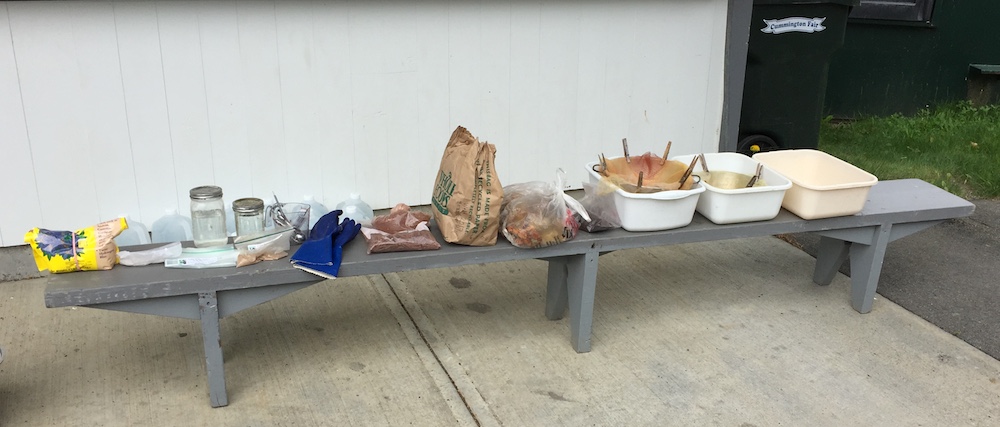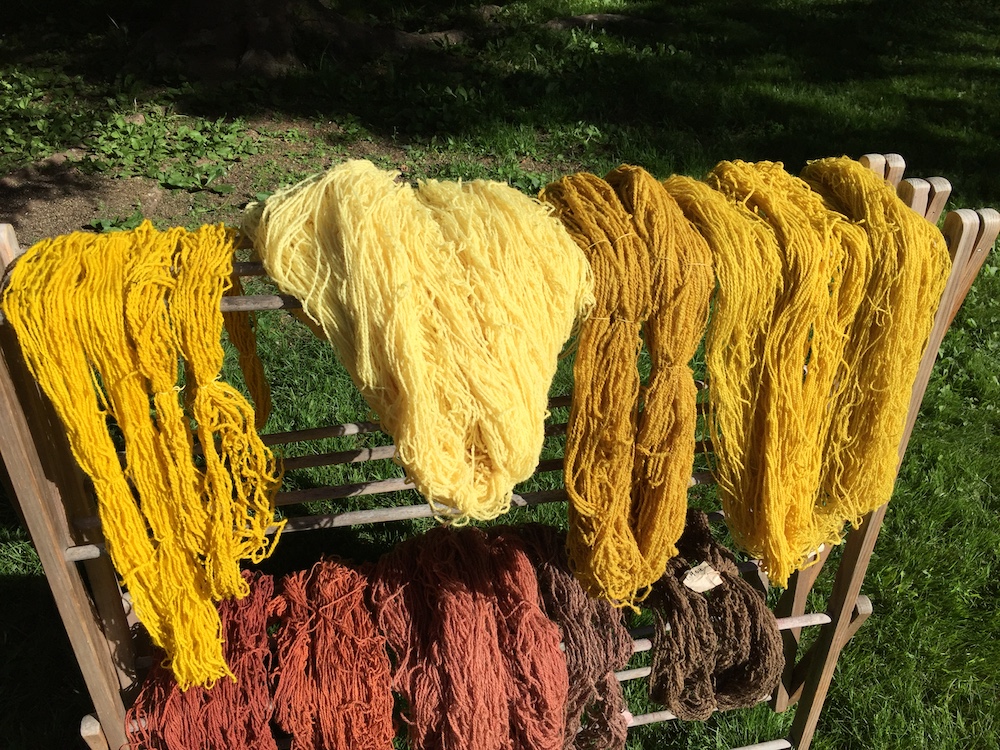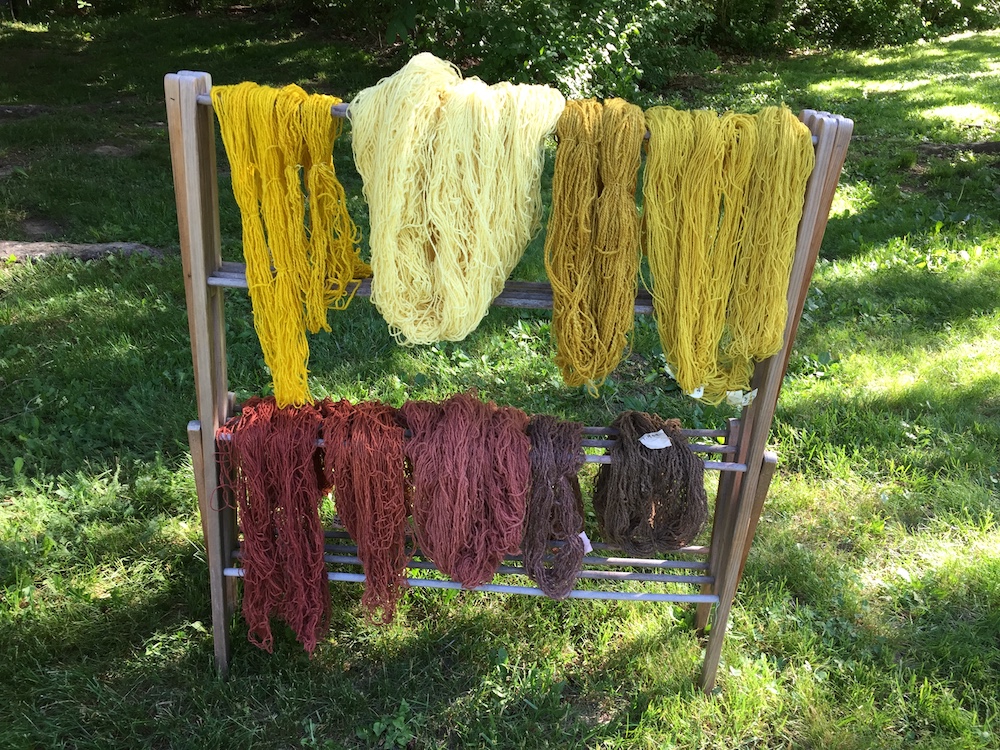On Memorial Day Weekend I did a dyeing demonstration at Massachusetts Sheep and Woolcraft Fair in Cummington, MA. I’ve done demos there before, but this year was special. I was dyeing hand-spun yarns from a variety of sheep breeds, spun by Lisa Bertoldi of Weft Handwoven Linens, and supported by a grant from the Northeast Handspinners Association. (12/31/2023 Edited: Lisa’s website is no longer active, but you can read her bio on the Working Weavers Studio Trail website. Here’s a link to her old site, including some nice images of her dishtowels.)
Here was the table with examples of my own naturally dyed handspun yarns, some of my favorite books, fliers for the Northeast Handspinners Association, and a 6-pack of marigolds:
Next to that I set up the portable electric burners and dye pots: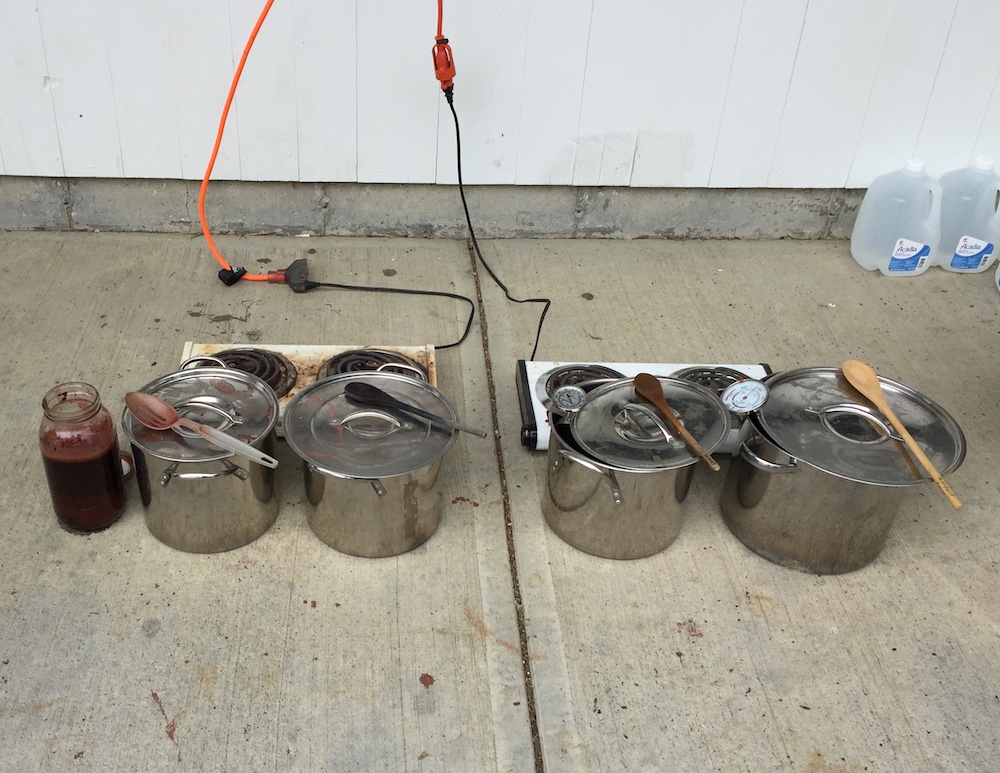
The jar on the left contains powdered madder roots that I weighed out and soaked in water the day before. The other dye plants I used that day were weld, marigolds, and black walnut hulls.
On a bench beside the pots I set out the tools, dried dye plants, tubs, measuring spoons, and other supplies, mordants and other additives that I would need:
I scoured and mordanted all the skeins ahead of time using aluminum sulfate. I transported them damp, and kept them in a tub of water to pull out and use as the day went along. In addition to Lisa’s skeins, which weighed about 13 ounces all together, I had prepped some mini-skeins from Green Mountain Spinnery in Vermont (from their end-of-the-run stash) and some natural colored wool yarn from Bartlett Yarns in Maine (a very light gray-brown).
Since my demo ran all day this year, I had plenty of time to make the dyebaths as well as dye the yarns. In each case, the dye plants heated in the dye pots for approximately an hour, then I let them cool off a little before straining out the plant material and putting in the yarn. Usually I like to let the fiber cool and soak overnight, but in this case I wanted to keep the process moving along fairly quickly.
Once the crowds arrived I took no pictures whatsoever! It was a busy day with lots of curious visitors, great questions and conversations, and a couple unexpected but pleasant surprises regarding color.
Some of the skeins that Lisa had spun were naturally colored browns and grays. I felt a little bad dyeing them, since they were already very lovely. But, that’s what I had to work with, so I just went for it.
Some of the visitors came back multiple times during the day to check on the progress of the dyebaths, and I was able to get suggestions from them about which skeins to try in which pots. One young visitor was especially engaged and came back several times. At the end of the day, I let that young person pick the ones they liked the best. Hence, I do not have photos of those skeins (a madder skein and a weld skein).
Here are the details for each dyebath:
Madder
The day before the demo, I weighed 3 ounces of powdered madder root from Dharma Trading and soaked it in plain tap water overnight in a tall glass jar. The day of the demo, I poured the whole jar into a pot with some additional water, heated it to 150 degrees F, and maintained that temperature for an hour.
Because the powder was very fine, it was hard to strain. The remaining dyebath was still a little sludgy. I added 1/2 a teaspoon of calcium carbonate and a glug of soda ash solution.The pH was 11, which is much higher than I was going for. So, I added more water and brought the pH down to 9. It also cooled off the bath a little.
In the first, strongest madder dyebath, I dyed a charcoal gray skein, at the suggestion of the young visitor I mentioned. The color turned out to be a very interesting shade of purple! I wish I had a photo of that one, and it’s an experiment worth repeating. The charcoal gray skein weighed about 2 ounces. That first bath heated for an hour, around 150 degrees.
Next, I put in two of the tiny Green Mountain Spinnery wind-offs (approx. 1 oz. each). The first exhaust bath heated for an hour. Alas, it got busy and I wasn’t watching the pots carefully. The first exhaust bath overheated and got up to a boil, but the color stayed pink nevertheless.
After the hour was up, I pulled those two out, and put in two more tiny Green Mountain skeins, plus a 4 oz. Bartlett skein. I heated them for 30 minutes.
At this point I added another of Lisa’s handspun skeins to the pot, a 1 oz. gray-brown skein. All the skeins stayed in the pot together for another 30 minutes, then I turned the heat off and pulled it off the burner to cool.
Back at home the next day, I finished exhausting the madder dyebath using another 4. oz skein of Bartlett’s. Before adding the wool, I added a little more soda ash solution and a half teaspoon calcium carbonate to get the pH back up to 9. I heated the pot to 140 degrees, and maintained that for an hour.
Here are the exhaust skeins after they were all rinsed and dry (the one on the far right is walnut-dyed):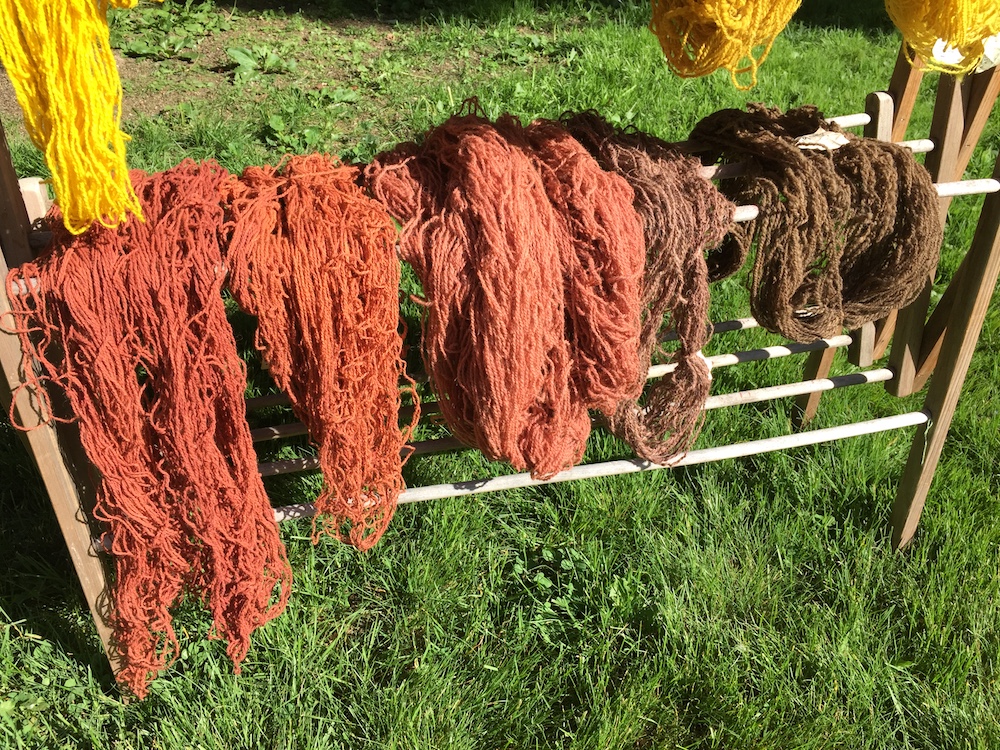
Weld
For the weld bath I used 7 ounces of dried weld (whole tops, including stalks, leaves and flowers). Normally I would soak this ahead of time, too, but for the demo I weighed out the plant material while people were watching, and only extracted it once. After the pot got up to about 150 degrees, it heated for hour. I only cooled it a little before straining. Then we added calcium carbonate and soda ash solution to get pH9, and I put in two of Lisa’s handspun skeins (total weight about 2 1/2 ounces). They heated for an hour. It was a very strong bath and we got vivid yellows!
One of Lisa’s white handspun skein weighing about 2 ounces went into the first weld exhaust bath. It was also bright but not quite so neon-electric as the first two. That skein also went home with the young person who was very excited and engaged with the whole process.
Back at home a couple days later, I exhausted the weld bath. It was pH 7, so I added half a teaspoon of calcium carbonate and some dissolved soda ash to get the bath to pH 9. Then I dyed a 6 oz. skein of my own handspun, mordanted with aluminum sulfate.
The top rack shows the weld-dyed skeins on the left hand side. The marigold skeins are on the right:
Marigold
I used 4 oz. of dried marigold flowers, all types of colors mixed together. People often ask me whether different colors of marigold give different shades of yellow or gold. I don’t actually know because I’ve never bothered to separate them. My hunch is that they all give basically the same color, but it might be worth it to test this out sometime.
The procedure for making the dyebath was the same as the weld, but I didn’t add any pH modifiers or other amendments. The first skein to go in the bath was a 6 oz. skein of Lisa’s. The skein heated about an hour, and turned a rich old gold color. In the marigold exhaust I put in two of the Green Mountain wind-offs, total weight just over 2 oz. They also yielded an old gold shade, but a little bit brighter. You can see the marigold-dyed skeins on the top right hand side of the drying rack above.
Black Walnut Hulls
I used 3 oz. of dried black walnut hulls for this demo. I usually use them fresh, and I wasn’t quite sure how dark of a bath this would give. The answer is, not very. I also only extracted them once: I brought the hulls and water up to about 150 degrees (could have been hotter, but that takes longer), held that for an hour, then strained out the hulls. In this short amount if time they probably didn’t have enough time to really soak and release their dye.
Nevertheless, the result was interesting. I used one of Lisa’s light brown skeins, about 2 oz., with a lot of gray. I didn’t think to take a “before” picture, but what happened was that the walnut shifted the grayer, cooler tone of the original skein to a warmer more yellow tone. You can see the skein in the image above, on the far right of the bottom rack with the madder dyed yarns. The pinkish-brown skein from madder exhaust is next to it.
Because color looks so different depending on the lighting, I also though it would be interesting to show how the skeins looked on the drying rack in the shade:
The weld exhaust looks so pale in this lighting, when in actuality it’s much brighter.

